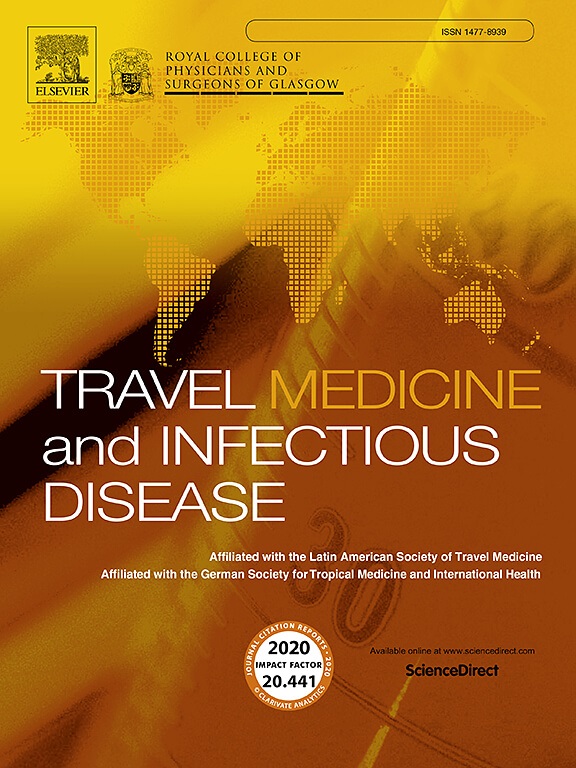国际旅行者暴露后狂犬病预防的延迟和不完全:泰国东部一个急救中心的7年回顾性研究
IF 4.7
3区 医学
Q1 INFECTIOUS DISEASES
引用次数: 0
摘要
背景:狂犬病仍然是一个重大的全球卫生问题。本研究的目的是确定与泰国东部国际旅行者狂犬病暴露后预防(PEP)延迟和不完全相关的危险因素。方法:对2016年1月至2022年12月528例国际患者的病历进行回顾性研究。采用Logistic回归分析延迟性PEP和不完全性PEP的相关因素。结果:10.1%的患者PEP延迟,45.6%的患者PEP不完全。与延迟PEP相关的因素包括年龄35-60岁(AOR: 3.08, 95% CI:[1.07, 8.86])、浅表伤口(2.86,95% CI:[1.38, 5.92])和单一伤口(1.88,95% CI:[1.01, 3.49])。不完全PEP与18-34岁和35-60岁相关(2.04,95% CI: [1.25, 3.32];2.28, 95% CI:[1.27, 4.09])和接触非犬类哺乳动物(2.05,95% CI:[1.29, 3.25])。既往狂犬病免疫(0.19,95% CI:[0.10, 0.36])和皮内疫苗接种方案(0.58,95% CI:[0.39, 0.84])与不完全性PEP风险较低相关。东南亚和非东南亚旅行者在狂犬病延迟和不完全PEP方面没有差异。结论:在本研究中,有很大比例的国际旅行者有延迟或不完整的狂犬病PEP。患者的年龄、伤口特征和动物类型是影响PEP依从性的关键因素。这些发现突出表明,需要采取有针对性的干预措施,以提高狂犬病流行地区国际旅行者对狂犬病预防措施的依从性。本文章由计算机程序翻译,如有差异,请以英文原文为准。
Delayed and incomplete rabies post-exposure prophylaxis among international travelers: A seven-year retrospective study at an emergency center in eastern Thailand
Background
Rabies remains a significant global health concern. The aim of this study was to identify risk factors associated with delayed and incomplete post-exposure prophylaxis (PEP) for rabies among international travelers in eastern Thailand.
Methods
A retrospective study was conducted using the medical records of 528 international patients from January 2016 to December 2022. Logistic regression was used to analyze factors associated with delayed and incomplete PEP.
Results
PEP was delayed in 10.1 % of the patients and incomplete in 45.6 % of the patients. The factors associated with delayed PEP included an age of 35–60 years (AOR: 3.08, 95 % CI: [1.07, 8.86]), superficial wounds (2.86, 95 % CI: [1.38, 5.92]), and a single wound (1.88, 95 % CI: [1.01, 3.49]). Incomplete PEP was associated with ages 18–34 and 35–60 years (2.04, 95 % CI: [1.25, 3.32]; 2.28, 95 % CI: [1.27, 4.09]) and exposure to a non-dog mammal (2.05, 95 % CI: [1.29, 3.25]). Previous rabies immunization (0.19, 95 % CI: [0.10, 0.36]) and an intradermal vaccination regimen (0.58, 95 % CI: [0.39, 0.84]) were associated with a lower risk of incomplete PEP. There was no difference in delayed and incomplete PEP for rabies between Southeast Asian and non-Southeast Asian travelers.
Conclusion
In this study, a large proportion of international travelers had delayed or incomplete PEP for rabies. The patient's age and wound characteristics and the animal type were key factors that influenced PEP adherence. These findings highlight the need for targeted interventions to improve adherence to rabies PEP among international travelers in regions where rabies is endemic.
求助全文
通过发布文献求助,成功后即可免费获取论文全文。
去求助
来源期刊

Travel Medicine and Infectious Disease
PUBLIC, ENVIRONMENTAL & OCCUPATIONAL HEALTH-INFECTIOUS DISEASES
CiteScore
19.40
自引率
1.70%
发文量
211
审稿时长
49 days
期刊介绍:
Travel Medicine and Infectious Disease
Publication Scope:
Publishes original papers, reviews, and consensus papers
Primary theme: infectious disease in the context of travel medicine
Focus Areas:
Epidemiology and surveillance of travel-related illness
Prevention and treatment of travel-associated infections
Malaria prevention and treatment
Travellers' diarrhoea
Infections associated with mass gatherings
Migration-related infections
Vaccines and vaccine-preventable disease
Global policy/regulations for disease prevention and control
Practical clinical issues for travel and tropical medicine practitioners
Coverage:
Addresses areas of controversy and debate in travel medicine
Aims to inform guidelines and policy pertinent to travel medicine and the prevention of infectious disease
Publication Features:
Offers a fast peer-review process
Provides early online publication of accepted manuscripts
Aims to publish cutting-edge papers
 求助内容:
求助内容: 应助结果提醒方式:
应助结果提醒方式:


